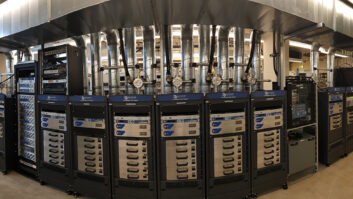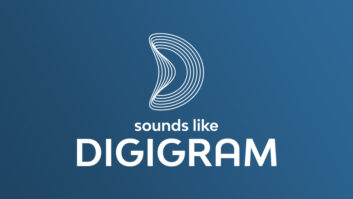Applied Technology: Digigram Exaudi
Dec 1, 2004 12:00 PM, By Philippe Delacroix and Carl Conrad
The radio industry has undergone a process of digitalization in recent years. Sound files have replaced carts and reel-to-reel tape. Digital editing workstations have supplanted scissors and razor blades. This has enabled radio automation and transformed the way radio operations are organized, changing the hierarchy of roles within the broadcast chain.
But the broadcast workflow still consists of a chain of specific tasks with defined interaction but virtually no interoperability. The technician sitting at the on-air console has almost no link to what happens at the transmitter site. Furthermore, big broadcasters that operate nationwide networks need to manage highly complex interactions to deliver their programs, including: multiple contributions, localized programming, localized advertising, complex audio transport and remote transmitters. Using traditional technology, these tasks often turn into nightmares and each failure rapidly turns into a catastrophe.

Functional flow diagram of the Exaudi. Click here to enlarge this image.
With the advent of digitized audio on the one hand and the likelihood of ever cheaper, powerful networking technologies on the other, Digigram believes that the use of networking techniques will become more and more important in radio broadcasting.
Networking technologies have become completely synonymous with distributed computing. Now that individual computers take care of all the tasks related to radio automation, the logical evolution is integration of audio transport for program contributions and distribution. This leads to a fully integrated network-centric view rather than a PC-centric approach.
Underpinning the Internet, the IP protocol provides extremely flexible routing as well as reduced communication costs and is an accepted, manufacturer-independent standard for transporting data over short and long distances. Its full separation from the hardware layer makes it suitable for professional applications running on LAN/WAN enterprise networks. With the constant increase of available bandwidth and the huge choice of protocols available, IP offers an ideal pathway for general IT/AV convergence, being able to carry a large variety of signals (audio, control, data). Additionally, IP technologies offer multiple stream capabilities. The advent of IPv6 will bring further maturity to the technical solutions.
A new approach
With the introduction of Exaudi, Digigram addresses the future needs of the radio broadcasting industry by providing a reliable and redundant system that combines radio automation and audio transport through IP streaming in a single system.
Exaudi integrates schemes based on a network application programming interface (API), thus enabling development partners to integrate the system into their applications. Exaudi is Linux based for reliability and stability, and the units are ruggedized with full hot-swap redundant power supplies.
While third party control applications take care of the user interface, this unit manages all low-level tasks related to audio automation and computer-assisted operation, locally and remotely, providing a comprehensive integration of the radio on-air transmission steps.
Streaming
Network technologies allow for streaming audio transport, which inherently supports routing and multicast distribution. The IP as the transport protocol in Exaudi brings a number of benefits:
- Native support of LAN/WAN technologies
- Cost reduction thanks to IP proliferation
- Full interoperability with most other equipment
- Easy mutualization and multiplexing of various streams
- Separation from the underlying physical network layers
- Support of IPv6
Many existing products for IP streaming do not address the requirements of the broadcast industry � high audio quality associated with low and constant latency � or at best address them with a lack of audio management flexibility. Exaudi ties the potential of IP networks with the native support of dedicated real-time protocols RTP, RTCP and RTSP. Quality of service ensures that proper priority and bandwidth is allocated to the stream in a shared system.
To meet the requirements of professional applications, it is vital to make sure that all audio information is broadcast simultaneously. This can only be achieved by buffering to compensate the delay and jitter between different locations added by the streaming process. Exaudi minimizes the buffering needed by implementing precise time compensation mechanisms and a proprietary connected system with a distributed NTP-based clock synchronization that ensures clock integrity between all the devices on the network.
Audio processing
The audio processing embedded in this equipment addresses three main needs: mixing, coding and improving audio quality. Exaudi takes advantage of the embedded DSP power to offer fading/cross fading, stream synchronization, coding/decoding, time stretching, mixing and routing capabilities.
Various data reduction algorithms can be implemented on the Exaudi platform: MPEG 1 and 2 layer 2, MP3, MPEG4/AAC+. Because Exaudi is an open and flexible platform it will be able to host almost all future audio coding or transcoding developments. A stream may be encoded into several different streaming formats.
All streams can be multicast streams, allowing significant bandwidth optimization and thus reducing overall costs.
Exaudi provides two levels of audio routing. One level is an embedded matrix that provides routing capabilities for any input (physical, file or IP stream) to any output (physical, file or IP stream). The other level is that the external routing between Exaudi units is inherent to the IP data network and allows for flexible audio routing from one unit to many others.
Each unit is fully remote controlled. Nevertheless, local management needs may require small, dedicated and highly specific applications to be hosted on each unit.
This approach allows for a boundary between the audio functions handled by Exaudi and the management applications that mainly take care of the HUI and other workflow related aspects. This boundary provides better system reliability by removing the risk of human error from the audio equipment.
As a consequence, these applications can be far lighter and focus on the user interfaces and workflow management functions.
Last but not least, SNMP management capabilities can provide network wide monitoring of many types of equipment and warn of system failure.
When used in the on-air studio, the system takes care of all the radio automation and audio streaming tasks. Remote controlled from the radio automation system, it manages all incoming and outgoing signals.
In addition to the main program stream, a transmitter feed, as well as ancillary streams for monitoring, logging or internal distribution may be implemented. The outgoing stream may also encapsulate service traffic used by the remote devices.

An application in the air studio. Click here to enlarge this image.
Logging and monitoring
Exaudi’s remote automated recording capability is useful for logging applications ranging from competitive monitoring to legally required logging. A unit can be instructed to record from an audio input or an IP stream and encode in real time. It can also encode streams for low level remote monitoring and audio distribution.
By locating a unit at the transmitter site, it ingests and adapts the audio stream in ways similar to on-air studio applications. These streams may be one or more main program streams fed by terrestrial or satellite links; secondary streams coming from other distant sites, for local programs or advertising; and live inputs or any other backup stream.
Exaudi applies all the required processing to the individual streams to generate the continuous program stream.
The service traffic provides information on when to switch from one program to another or when to insert localization data downloaded off-line and stored locally.
Thus, the device facilitates the installation directly at the transmitter site, which provides the broadcaster with great flexibility. The installation of a control application at its own premises gives the broadcaster, for the first time, a high level of autonomy over his network operator.
An Exaudi system can take care of everything specific to multiple localized programs. At each transmitter site, units receive programs via unicast or multicast IP streams and handle the local mixing, advertising insertion, program localization and scheduling. Localization jingles, a backup program and advertising can be downloaded at any time and stored at the transmission site.
This architecture also provides the functionality needed to assemble programs for affiliate radio stations running shared programs, while also being capable of switching to a live program interactively or at any predefined time.
The network-centric approach makes this instrument a flexible workhorse capable of handling a wide variety of tasks. Because the units are stand-alone, ready-to-use boxes, they are simpler to integrate than PC sound cards. There is no need to open a computer or to install drivers.
Exaudi sits at the link between the computer and the network but is more than just another streaming system or another codec. Exaudi is a comprehensive system providing tight integration between radio automation and audio transport.
Download a whitepaper atwww.digigram.com/exaudi_whitepaper
Delacroix is managing director of Digigram, and Conrad is product manager, networked audio of Digigram.












